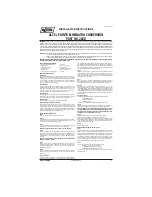
Catalog #70080, #70081, #70082, #70083
Brochure No. 63-0312
©2008 Edelbrock Corporation
Rev. 07/08
Page 27
When using aftermarket ignition components and/or systems, it would be advisable to contact the manufacturer for
information on using their components with a nitrous system. It is always better to be very conservative in your timing
approach and tune towards an optimum timing setting.
Example:
Ignition timing without Nitrous Oxide
38 degrees “total”
100 HP increase from Nitrous Oxide
4 degrees “retard”
Initial safety margin
2 degrees “retard”
Total timing with Nitrous Oxide
32 degrees “total”
The following test plan, for determining ignition timing, will give you a guide to determine the best timing profile for your
vehicle, hopefully avoiding engine damage during the tuning phase:
1
Install the nitrous jetting for a selected horsepower increase. Use the 100 horsepower setting to learn the finer
points of working with nitrous oxide. This will keep your margin for error as large as possible.
2.
Estimate the reduced ignition timing that you think will produce best power, based upon the 2° retard per 50 HP
increase rule.
3.
Set ignition timing 2°-3° retarded from your best power estimate setting. This is your cushion for error.
4.
Stabilize nitrous bottle pressure at 900 to 950 psi. It is best to select a pressure and keep the pressure to ±¼
psi.
5.
Run your vehicle in a controlled manner (like a ¼ mile drag strip) without the use of nitrous. This is called “on
motor” .Note vehicle mph as a baseline to measure nitrous assisted increases.
6.
Adjust your ignition timing to a nitrous timing setting.
7.
Run your vehicle in the same controlled manner (like a ¼ mile drag strip) with the use of nitrous. Note vehicle
mph increase and compare it to your baseline.
Note:
Listen for any knocking sounds when running the vehicle. Watch your temperature gauges. Continued
nitrous use will elevate coolant temperatures. See Testing Checklist for more testing methodology helpful hints.
8.
What Happened? Did your vehicle go faster? Slower? What did the engine sound like? Did the nitrous system
work? Refer to the timing charts, and examine spark plugs for signs of detonation.
a.
If power increased or vehicle mph increased and your spark plugs show no signs of overheating or detonation,
you could try to increase ignition timing 1° to 2°.
b.
If power increased or vehicle mph increased and spark plugs begin to show slight signs of detonation - STOP!
Do not advance timing further. You may choose to reduce timing 2° at this point for an extra margin of safety.
At this point, you need to look at the “Troubleshooting” section for assistance. Pay close attention to the fuel
supply with your nitrous system.
c.
If power decreases or vehicle mph decreases, check for burned spark plug or engine damage, and reduce
ignition timing 2°. Please refer to the “Troubleshooting” section of this manual for help in determining any
system trouble you may feel that you are having.
9.
Repeat step 6 until optimum ignition timing is obtained.




































